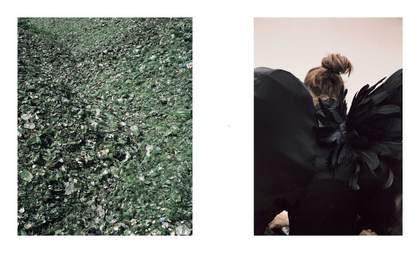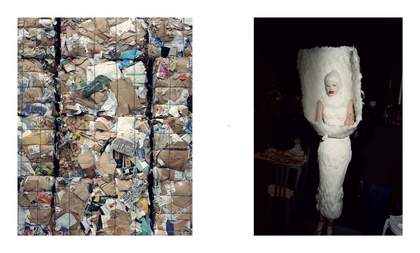
Nick Waplington, Untitled, 2008-2009
I had been friends with Lee (his first name) for a long time. He approached me a couple of years before the project as he was concerned about his legacy. It was known that he had this very innovative working process, but no one got to see it – it was all extremely guarded. He knew that I like making photobooks, so he said to me: ‘Can you make me something dirty and messy like your photobooks?’ I said to him: ‘Look, Lee, this is fashion. I don’t think it’s very dirty and messy, but we can try.’
He used to come and hang out in my studio in Hackney Wick, east London, where I would be working on my photographs and paintings. Sometimes the Chapman Brothers and other artists would be there, and he saw that this was a world he wanted to be in. By getting involved with me, it was another creative outlet for him, even though he was very tied to the McQueen company. He was also looking at art as well as collecting and commissioning it. And he saw his work not just as fashion. As it happens, he was hoping to move away from that world. In fact, the big secret was that when he died he had been accepted to do a fine arts MA at the Slade.
In terms of the Working Process book, it was very much stated that this was my work, but there was a very collaborative element to it in the editing. I wanted it to be not just a fashion book, so I had these ‘intervention’ pictures, which included some landscapes of waste ground, which happened to be near the area where Lee went to school in east London. We didn’t want it to be like any other photobook that we’d seen before, and the intervention pictures that cut up the action in the photographs would also reflect how we saw society at the time.

Nick Waplington, Untitled, 2008-2009
It was a very topographic landscape, something that he was really intrigued by. When I had made those particular pictures about 12 years ago, I was interested in Lewis Baltz’s book Candlestick Point. I was thinking: can I make something in east London that deals with the landscape in a way that Baltz was dealing with the landscape in California which can also have a British aesthetic? And Lee picked up on that.
All the photographs were shot on negative and I made colour work prints, 600 of them, by hand. It took six weeks. Then I pinned these to the wall of the studio, and from there we had to narrow it down with careful editing together to about 250. After that we had a huge maquette made of the book (to be included in the exhibition), with the prints off the wall.
